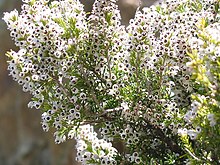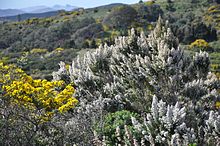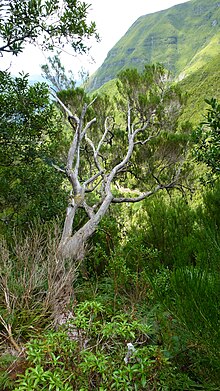Erica arborea, the tree heath or tree heather, is a species of flowering plant (angiosperms) in the heather family Ericaceae, native to the Mediterranean Basin and Ethiopia, Kenya and Tanzania in East Africa.[1] It is also cultivated as an ornamental.
| Erica arborea | |
|---|---|

| |
| Scientific classification | |
| Kingdom: | Plantae |
| Clade: | Tracheophytes |
| Clade: | Angiosperms |
| Clade: | Eudicots |
| Clade: | Asterids |
| Order: | Ericales |
| Family: | Ericaceae |
| Genus: | Erica |
| Species: | E. arborea
|
| Binomial name | |
| Erica arborea | |

| |
| Distribution map | |


The wood, known as briar root (French: bruyère, Catalan: bruc, Portuguese: betouro, Spanish: brezo), is extremely hard and heat-resistant, and is used for making smoking pipes. Leaf fossils attributed to this species were described for the Mio-Pleistocene deposit of São Jorge in Madeira Island.[2]
Description
editErica arborea is an upright evergreen shrub or small tree with a typical height in the wild of some 7 m (23 ft), especially in Africa, but more typically 1–4 m (3–13 ft) in gardens. It bears dark green needle-like leaves and numerous small honey-scented bell-shaped white flowers. It is a calcifuge, preferring acid soil in an open sunny situation.[3]
Distribution and habitat
editThe heather has a disjunct distribution, including Macaronesia, the Mediterranean Basin, Western Caucasus, eastern Africa, and the Arabian Peninsula.
In Macaronesia, it occurs in thermophilous forests, dominating dry and shallow soils, southern aspects, and forest margins.[4]
Throughout the Mediterranean Basin, its distribution is not continuous, extending from the Atlantic coasts of Portugal and Spain to the coast of the Black Sea in Turkey and Georgia. The heather partecipates to the Mediterranean maquis shrublands in semi-harid habitats, but can also be found in forest undergrowth up to 1400 m a.s.l. in fresher and more humid environments. It prefers acidic or acidified soils derived from siliceous substrates.[5] [4]
It is also present in an isolated population in the Tibesti Mountains (Chad) in the Sahara, where it occurs at the top of upper montane desert steppe vegetation between 2500 and 3000 m a.s.l.[6]
In eastern Africa is normally referred to as giant heather. It occurs in the Ethiopian highlands, in the highest mountains along the East African Rift System, from southern Uganda to northern Malawi. It is also present in the Sarawat Mountains in the southwestern Arabian Peninsula, including Yemen and Saudi Arabia. In Africa and the Arabian Peninsula, the heather is a constituent of the tropical alpine vegetation, dominating the shrubland above the treeline in mountain areas between 3000 and 4000 m a.s.l.[4]
Naturalised populations occur in south-eastern Australia and New Zealand, where tree heath is seen as a potential environmental weed.[7]
Cultivars
editSeveral cultivars and hybrids have been developed for garden use, of which the following have gained the Royal Horticultural Society's Award of Garden Merit:[8]
- E. arborea 'Estrella Gold'[9] (gold-tipped leaves)
- E. arborea var. alpina[10]
- E. arborea var. alpina f. aureifolia 'Albert's Gold'[11] (gold-leaved)
- E. × veitchii 'Gold Tips'[12] (E. arborea × E. lusitanica)
Other tall growing heaths, including the Portugal Heath (Erica lusitanica) and channel heath (Erica canaliculata) may also sometimes be called tree heath.
Uses
editThe wood, known as briar root, is extremely hard, dense and heat-resistant, and is primarily used for making smoking pipes, as it does not affect the aroma of tobacco. The football-sized tubers are harvested at the age of 30 to 60 years. They are cooked for several hours, then dried for several months before they are further processed.
The wood is also used for making jewellery, fountain pens and knife handles.
See also
editReferences
edit- ^ a b Harvey-Brown, Y.; Barstow, M. (2017). "Erica arborea". IUCN Red List of Threatened Species. 2017: e.T73094040A109616921. doi:10.2305/IUCN.UK.2017-3.RLTS.T73094040A109616921.en. Retrieved 19 November 2021.
- ^ Góis-Marques, Carlos A.; Madeira, José; Sequeira, Miguel Menezes de (2018-01-26). "Inventory and review of the Mio–Pleistocene São Jorge flora (Madeira Island, Portugal): palaeoecological and biogeographical implications". Journal of Systematic Palaeontology. 16 (2): 159–177. Bibcode:2018JSPal..16..159G. doi:10.1080/14772019.2017.1282991. hdl:10400.13/4191. ISSN 1477-2019. S2CID 132935444.
- ^ RHS A-Z encyclopedia of garden plants. United Kingdom: Dorling Kindersley. 2008. p. 1136. ISBN 978-1405332965.
- ^ a b c Désamoré, A., Laenen, B., Devos, N., Popp, M., González-Mancebo, J. M., Carine, M. A., Vanderpoorten, A. (2011). Out of Africa: north-westwards Pleistocene expansions of the heather Erica arborea. Journal of Biogeography, 38(1), 164-176. DOI: 10.1111/j.1365-2699.2010.02387.x
- ^ Reille, M., Gamisans, J., Andrieu-Ponel, V., De Beaulieu, J. L. (1999). The Holocene at Lac de Creno, Corsica, France: a key site for the whole island. New Phytologist, 141(2), 291-307. DOI: 10.1046/j.1469-8137.1999.00343.x
- ^ Dinies, M., Schimmel, L., Hoelzmann, P., Kröpelin, S., Darius, F., Neef, R. (2021). Holocene high-altitude vegetation dynamics on Emi Koussi, Tibesti mountains (Chad, central Sahara). In: Runge, J., Gosling, WD, Lézine, A.-M., Scott, L., (Eds). Quaternary Vegetation Dynamics — The African Pollen Database, 1st ed. CRC Press, 27-50. DOI: 10.1201/9781003162766
- ^ *Noble, M. R. (2016). The weed potential of Erica species for Tasmania and other areas of southern Australia. 20th Australasian Weeds Conference, 11-15 September 2016, Perth, Western Australia.
- ^ "AGM Plants - Ornamental" (PDF). Royal Horticultural Society. July 2017. p. 35. Retrieved 6 February 2018.
- ^ "RHS Plant Selector - Erica arborea 'Estrella Gold'". Retrieved 7 June 2020.
- ^ "RHS Plant Selector - Erica arborea var. alpina". Retrieved 7 June 2020.
- ^ "RHS Plant Selector - Erica arborea var. alpina f. aureifolia 'Albert's Gold'". Retrieved 7 June 2020.
- ^ "Erica × veitchii 'Gold Tips'". RHS. Retrieved 7 June 2020.
External links
edit- Adams, W.M., A.S. Goudie & A. R. Orme (eds.) (1996): The Physical Geography of Africa. Page 55. Oxford University Press.
- Dressler, S.; Schmidt, M. & Zizka, G. (2014). "Erica arborea". African plants – a Photo Guide. Frankfurt/Main: Forschungsinstitut Senckenberg.
